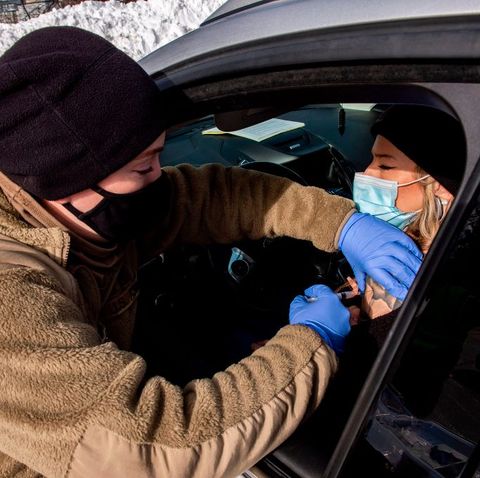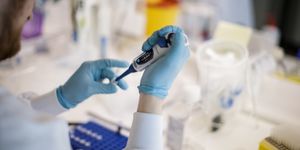She was in the shower when she first felt it. A lump where no woman ever wants to find one. Just below the armpit, near the side of the breast. It
was uncomfortable to touch, and big—about the size of a golf ball.
After drying off, she immediately texted her doctor: I think I might have breast cancer.
"I panicked," says *Samantha, a 33-year-old psychotherapist from California who requested anonymity in this story. "I had trouble sleeping and it's not like I could easily forget about it. Every time I got dressed or moved my arm, it was there."
At an appointment the next week, Samantha's gynecologist referred her to a breast screening specialist, who asked whether she recently received the COVID-19 vaccine. She had, seven days earlier. Moderna. On her left arm—the same side as the lump.
An ultrasound test put Samantha's mind at ease. It wasn't breast cancer. The lump was actually an enlarged lymph node, a side effect from the COVID-19 vaccine that, as of publication date, has been administered to more than 43 million Americans since distribution began last year.
When Samantha's lump faded after a few days, it felt like she could "finally breathe" again. "All those sleepless nights, the constant worrying—it was all for nothing," she says.
The two COVID-19 vaccines now available in the U.S., Moderna and Pfizer, affect recipients differently. Some people experience chills or body aches. Others complain of fatigue and soreness around the injection site. Another known side effect is axillary lymphadenopathy, or enlarged lymph nodes in the armpit area. The swelling can appear two to four days after vaccination, according to the CDC, and last for approximately ten days. The CDC also reports that about 11 percent of people who receive the Moderna vaccine will experience swollen lymph nodes after their first dose. That percentage increases to 16 percent after the second dose.
These "reactive" nodes, as they're called, vary in size and location. When they form in the underarm region, they appear very similar to a cancer from the breast that has traveled to other parts of the body. According to the National Breast Cancer Foundation, when breast cancer spreads, it goes through a customary path, out from the tumor and first into the surrounding lymph nodes, before progressing throughout the body.
"There's a difference between cancerous lymph nodes and reactive lymph nodes," says Dr. Elizabeth R. Berger, an Assistant Professor of Surgery at Yale's School of Medicine. "Reactive lymph nodes are enlarged, just like cancerous lymph nodes, but obviously don't have cancer in them." However, during breast exams and image testing it can be, "very hard to tell whether or not a lymph node is just reactive or cancerous," says Berger. "Anyone who has had a history of breast cancer will presume that's cancer until proven otherwise."

When Samantha got her COVID-19 vaccine shot, she experienced body aches and fatigue for 48 hours. She didn't notice the lymph node until those other symptoms had already subsided, which she says is why she "didn't connect the dots right away."
"My aunt had breast cancer and is in remission, and there's been other types of cancer on my paternal side," she adds, "so I definitely thought this was something serious."
Aubrey Lewis, a registered nurse at University Hospitals Cleveland Medical Center, was equally as nervous when she felt her underarm lump. It was four days after she received the Moderna vaccine in her left arm. "I went online to do some research and realized there are a lot of women out there who think they have breast cancer only to find out it's just a swollen lymph node," says Lewis. "People who aren't in the medical field might not know that it could be a lymph node. This is information that should be more widely known, so that women don't unnecessarily freak out."
The number of women concerned their swollen lymph nodes might be a sign of breast cancer will only increase as the vaccine continues to become more widely available, according to Berger. "There's a huge piece of education here [for healthcare workers] and our patients themselves," she says. "Unfortunately I think this is going to cause a lot of anxiety for a lot of people."
"I hope my experience spares people an unnecessary scare and encourages them to move forward with being able to get the vaccine whenever they're able to."
Dr. Andrea Silber, a breast oncologist and Berger's colleague at Yale, says the lymph node should start getting better within two to four weeks. "If it doesn't, that's when it needs to be evaluated," says Silber. "[A lump] could be due to the shot, but it can also be related to something else. That's why it is really important that people do still continue to get their mammography screenings. If the lump doesn't go away, it has to be evaluated, whether someone's had a shot or not."
The last thing Samantha wants is for her experience to discourage people from seeking medical treatment or from getting the COVID-19 vaccine. "Instead, I hope my experience spares people an unnecessary scare," she says, "and encourages them to move forward with being able to get the vaccine whenever they're able to."



